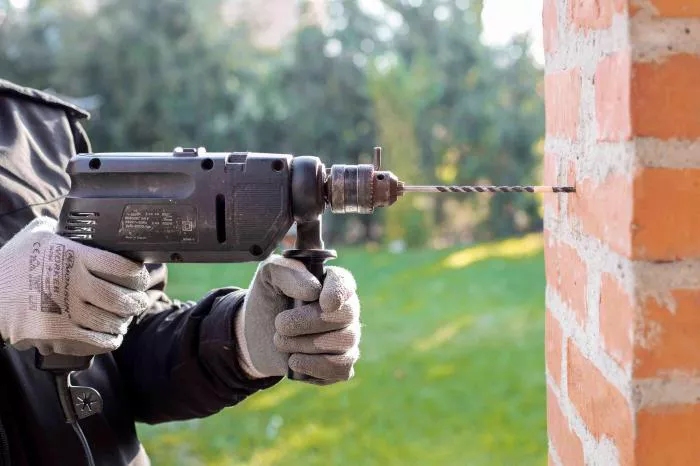Brick presents unique challenges that require specialized drilling equipment. Unlike wood or metal, brick is a brittle composite material that demands proper tool selection to achieve clean holes without cracking or chipping. The composition of brick varies between clay, concrete, and sand-lime types, each requiring slightly different drilling approaches.
Masonry drilling differs fundamentally from other drilling applications. The process involves a combination of crushing and grinding actions rather than the shearing action used for wood or metal. This distinction makes hammer drill functionality essential for most brick drilling applications above small diameters.
Key Features in Brick Drills
Rotary hammer mechanisms separate quality brick drills from standard models. These mechanisms deliver rapid, short hammering motions while simultaneously rotating the bit. The impacts fracture the brick material while the rotation clears debris from the hole. Most professional-grade models offer adjustable hammering intensity to match different brick densities.
Chuck systems represent another critical differentiator. SDS-plus and SDS-max chuck systems provide secure bit retention while allowing the hammering motion to transfer efficiently to the bit. Traditional keyed chucks may slip under the vibrations of masonry drilling, leading to inefficient power transfer and potential safety hazards.
Top Professional Grade Brick Drills
Bosch GBH 2-28 DV stands as a benchmark in rotary hammer drills for brickwork. Its 2.7 Joule impact energy handles brick drilling effortlessly while remaining manageable for extended use. The anti-vibration system reduces operator fatigue, a crucial feature for professional masons completing all-day installations.
Makita HR2475 combines affordability with professional performance. The 7.0 amp motor delivers ample power for brick drilling, while the compact design improves accessibility in tight spaces. Users particularly appreciate the tool’s depth stop mechanism, which ensures consistent hole depths across multiple drilling locations.
Optimal Drill Bits for Brick Applications
Carbide-tipped masonry bits remain the undisputed choice for brick drilling. The tungsten carbide tips maintain sharpness far longer than standard steel bits when drilling abrasive brick materials. Bit designs with spiral flutes prove most effective at removing brick dust from deep holes, preventing bit binding and overheating.
Diamond core bits become necessary for larger diameter holes in brick. These expensive but long-lasting bits use industrial diamond particles embedded in a metal matrix to grind through brick cleanly. Water cooling systems often accompany diamond core drilling setups to control dust and extend bit life.
The actual drilling process requires careful execution to avoid damage and ensure accuracy. Set up the drill by inserting the masonry bit into your hammer drill and securing it firmly. Begin the drilling process by positioning the bit on the marked spot and starting at a slow speed. This creates a small indentation that helps guide the drill. Apply steady pressure while gradually increasing the speed. Avoid forcing the drill; let the bit cut through the brick at its own pace. If your drill features a hammer function, use it to assist in breaking through the hard surface. Periodically, pull the drill out to remove dust and debris from the hole, ensuring a cleaner and more accurate result.
Safety Considerations for Brick Drilling
Respiratory protection often gets overlooked in brick drilling operations. Brick dust contains crystalline silica, a known respiratory hazard. Professional contractors should always use NIOSH-approved respirators with P100 filters when drilling brick, especially in confined spaces with limited ventilation.
Hearing protection represents another essential safety measure. Rotary hammer drills typically operate at 95-105 decibels, well above safe exposure limits. Combination earplug/earmuff systems provide adequate noise reduction for extended brick drilling sessions while allowing communication on job sites.
Accurate placement is key to a successful drilling job. Determine the exact location where you want to drill using a tape measure. This ensures that your fixture or installation will be correctly positioned. Once you have pinpointed the spot, use a pencil or marker to make a small, clear mark on the brick. This mark should be visible but unobtrusive. Make sure it is level and aligned with your project’s needs. A precise mark is crucial for drilling accurately and achieving the desired result. Consider using a level or a template if you need multiple holes to ensure they are aligned.
Maintenance Practices for Longevity
Regular grease application preserves the hammer mechanism in brick drills. Most professional models feature accessible grease ports for routine maintenance. Manufacturers typically recommend specific grease types that maintain viscosity under the high temperatures generated during extended brick drilling.
Carbon brush inspection prevents unexpected motor failures. Brick drilling places heavy loads on drill motors, accelerating brush wear. Professionals should establish routine inspection schedules, replacing brushes before they wear completely and risk damaging the motor commutator.
Conclusion
Selecting the proper drill for brickwork requires understanding both the material properties and job requirements. Professional-grade rotary hammer drills with appropriate safety features and maintenance practices deliver the best results for serious masonry work. By investing in quality equipment and following proper techniques, contractors can achieve precise, efficient brick drilling with minimal material damage and maximum tool longevity.
Relate topics:
- How to Drill Through Brick: A Step-by-Step Guide
- How to Drill into Brick?
- 5 Best Cordless Drills for Homeowners:The Ultimate Guide

